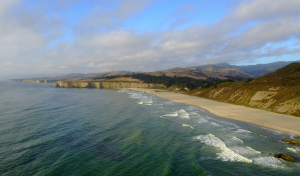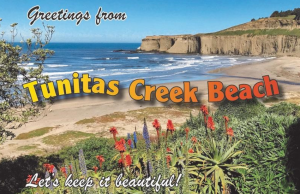* Tunitas Creek Beach is currently closed*
Halfway between Pescadero and Half Moon Bay lies Tunitas Creek Beach, a stunning stretch of coastline bordered by sandstone cliffs. These 58 acres are slated to become the newest park in the San Mateo County Parks system when it opens in late 2024. Peninsula Open Space Trust (POST) purchased this property from singer Chris Isaak in 2017. In March 2020, the San Mateo County Board of Supervisors voted 5 – 0 to buy Tunitas Creek Beach from POST at a below market rate.
At that point, San Mateo County Parks, in partnership with POST and the Coastal Conservancy, embarked on planning for improvements that will protect the environmental resources of Tunitas Creek Beach as well as promote safe visitor access. This was done virtually during the pandemic and lots of community input was received to create a Preferred Conceptual Design which was released in December 2020. In February 2021, the Board of Supervisors approved the preferred conceptual design for the Tunitas Creek Beach Improvement Project.
Improvements will include parking, restrooms, overlooks, a loop trail, interpretive signs, picnic tables and more.
Natural Features
A mix of habitats make up Tunitas Creek Beach including coastal scrub, coastal dunes and a dense forest of Monterey pine and Monterey cypress confined to the northeastern section of the site. California sagebrush, coyote brush, California coffeeberry and coastal marsh milk-vetch are some of the vegetation types found on site.
Tunitas Creek is a 6.6-mile perennial stream originating from King’s Mountain in the Santa Cruz Mountains that flows to the Pacific Ocean at Tunitas Creek Beach. Here, visitors are afforded sweeping views of the Pacific Ocean from the steep bluffs thanks to a lack of tall trees. Those bluffs have created challenges with accessing the site and over the years, informal trails have led to the degradation of the slopes which are prone to erosion.
The beach provides ideal nesting habitat for the western snowy plover, a shorebird whose nesting season (March – September) coincides with beach season. The snowy plover is federally listed as threatened. Increased beach use by humans, including overnight campouts, disturbed this bird to such a degree that it was driven from this site. The Preferred Conceptual Design includes a snowy plover habitat protection zone. The hope is that with time, this bird will reestablish itself here.
Other likely inhabitants of Tunitas Creek Beach include the San Francisco garter snake, California red-legged frog and monarch butterfly.

Photo by Rob Cala
History
Tunitas Creek Beach has a rich history which will be interpreted on-site, starting with a land acknowledgement to the Ohlone who for centuries used this area as a seasonal village.
Spanish explorer Gaspar de Portolá and his men camped along Tunitas Creek during his 1769 expedition from Baja California to San Francisco Bay. This was a pivotal moment in California history that led to the Spanish mission era.
Then, in the early days of the 20th century, a group of prominent San Franciscan businessmen incorporated the Ocean Shore Railroad in 1905 with dreams of connecting the City to the burgeoning resort town of Santa Cruz. However, for a host of reasons that included competition from Southern Pacific Railroad, the 1906 earthquake, and the growing popularity of the private automobile, the line was never completed and only got as far at Tunitas Creek. Most of the railroad’s former track became Highway 1.
In more recent times, this scenic and remote beach became extremely popular with beach visitors and overnight campers. However, due to the site’s difficult access as well as no public facilities, trash, human waste and dangerous parking conditions began to pile up. A local group, TLC Locals, organized countless beach clean ups, but the unsanitary conditions and degradation of the site warranted a bigger solution, hence current efforts to transform Tunitas Creek Beach into the newest San Mateo County Park.





